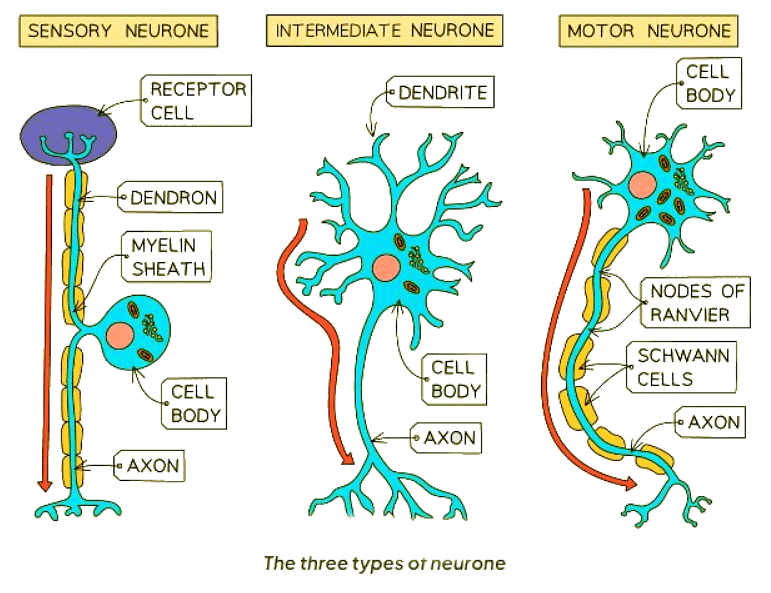Year 11 Exam > Year 11 Notes > Biology for GCSE/IGCSE > Types of Neurones
Types of Neurones | Biology for GCSE/IGCSE - Year 11 PDF Download
Neurone Diagrams
- There are three primary types of neurons: sensory, relay, and motor.
- Sensory neurons transmit signals from sensory organs to the central nervous system (CNS), comprising the brain or spinal cord.
- Relay neurons are situated within the CNS and serve as connectors between sensory and motor neurons.
- Motor neurons convey signals from the CNS to effectors, such as muscles or glands.
- Neurons feature elongated fibers known as axons.
- This elongation minimizes time wastage in transmitting impulses between cells.
- The axon is enveloped by a fatty sheath, interrupted by small uninsulated segments called nodes.
- Consequently, the electrical impulse traverses the axon by jumping from one node to another.
- Neurons possess a cell body containing numerous extensions called dendrites.
- This structural aspect enables neurons to establish connections with multiple other neurons, facilitating the reception of impulses and forming a network for efficient communication.
Identifying the types of neurone

- Sensory neurons are characterized by their elongated structure, with a cell body branching off the middle of the axon.
- Relay neurons, in contrast, are relatively short and feature a small cell body at one end, from which numerous dendrites extend.
- Motor neurons exhibit a long configuration, with a prominent cell body at one end and extensive dendrites branching off it.
Question for Types of NeuronesTry yourself: Which type of neuron is responsible for transmitting signals from sensory organs to the central nervous system?View Solution
The document Types of Neurones | Biology for GCSE/IGCSE - Year 11 is a part of the Year 11 Course Biology for GCSE/IGCSE.
All you need of Year 11 at this link: Year 11
|
110 videos|158 docs|34 tests
|
FAQs on Types of Neurones - Biology for GCSE/IGCSE - Year 11
| 1. What are the main types of neurones found in the human body? |  |
Ans. The main types of neurones found in the human body are sensory neurones, motor neurones, and interneurones.
| 2. What is the function of sensory neurones? |  |
Ans. Sensory neurones carry signals from the sensory receptors to the central nervous system, allowing us to perceive and respond to stimuli in the environment.
| 3. How do motor neurones contribute to bodily functions? |  |
Ans. Motor neurones transmit signals from the central nervous system to muscles and glands, enabling voluntary and involuntary movements as well as secretions.
| 4. What role do interneurones play in neural communication? |  |
Ans. Interneurones act as connectors between sensory and motor neurones, facilitating communication within the central nervous system.
| 5. Can neurones regenerate or repair themselves after damage? |  |
Ans. While some peripheral neurones have the ability to regenerate to a certain extent, central neurones in the brain and spinal cord typically do not regenerate well after damage.

|
Explore Courses for Year 11 exam
|

|
Signup for Free!
Signup to see your scores go up within 7 days! Learn & Practice with 1000+ FREE Notes, Videos & Tests.
Related Searches
















